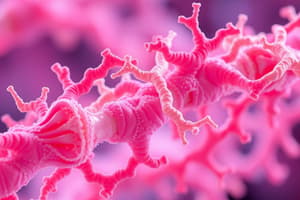Podcast
Questions and Answers
What are the main structural proteins found in the extracellular matrix?
What are the main structural proteins found in the extracellular matrix?
Collagen, elastin, fibrillin
What are the main amino acids associated with collagen?
What are the main amino acids associated with collagen?
- Lysine
- Glycine (correct)
- Hydroxyproline (correct)
- Proline (correct)
Collagen is the least abundant protein in the human body.
Collagen is the least abundant protein in the human body.
False (B)
What is the significance of hydroxyproline in collagen?
What is the significance of hydroxyproline in collagen?
Which cells are responsible for the synthesis of collagen?
Which cells are responsible for the synthesis of collagen?
Collagen is formed of three polypeptides known as ______.
Collagen is formed of three polypeptides known as ______.
How many types of collagen are found in human tissues?
How many types of collagen are found in human tissues?
What modification occurs after proline and lysine residues are incorporated into polypeptide chains of collagen?
What modification occurs after proline and lysine residues are incorporated into polypeptide chains of collagen?
Flashcards are hidden until you start studying
Study Notes
Extracellular Matrix (ECM)
- Gel-like substance found in the extracellular space, forming part of connective tissue.
- Composed of structural proteins, glycoproteins, and proteoglycans.
Components of ECM
- Structural Proteins: Include collagen, elastin, and fibrillin, providing support and strength.
- Glycoproteins: Less carbohydrate content; examples include fibronectin and laminin.
- Proteoglycans: High carbohydrate content (up to 95%), mainly composed of glycosaminoglycans (GAGs).
Collagen
- Most abundant protein in the human body and a major component of ECM.
- Provides tough, high-tensile strength through its fiber structure.
Collagen Structure
- Composed of three polypeptide α chains forming a rigid, rope-like triple helix structure.
- Held together by hydrogen bonds between the chains.
- Each α chain consists of roughly 1000 amino acids, leading to over 25 different types of collagen.
Amino Acid Sequence
- Rich in proline and glycine, with a repeating sequence of –Gly–X–Y–.
- X is often proline.
- Y is frequently hydroxyproline (or hydroxylysine).
- Glycine occupies every third position in the polypeptide chain.
Hydroxyproline and Hydroxylysine
- Unique to collagen; formed by hydroxylation of proline and lysine residues post-translation.
- Hydroxyproline stabilizes the triple-helical structure, enhancing hydrogen bonding.
Biosynthesis of Collagen
- Synthesized by fibroblasts, osteoblasts (bone), and chondroblasts (cartilage).
- Involves post-translational modifications, including hydroxylation and glycosylation.
- Collagen is secreted into the ECM, where enzymatic modifications allow aggregation and cross-linking into fibers.
Biosynthetic Pathway
- Formation starts with pre-pro-α chains (signal sequence present).
- Transitions to pro-α chains (signal sequence cleaved), followed by hydroxylation and glycosylation.
- Pro-collagen moves from the rough endoplasmic reticulum to the Golgi apparatus before secretion.
- Outside the fibroblasts, propeptides are cleaved, resulting in insoluble tropocollagen molecules that aggregate to form functional collagen fibers.
Studying That Suits You
Use AI to generate personalized quizzes and flashcards to suit your learning preferences.




